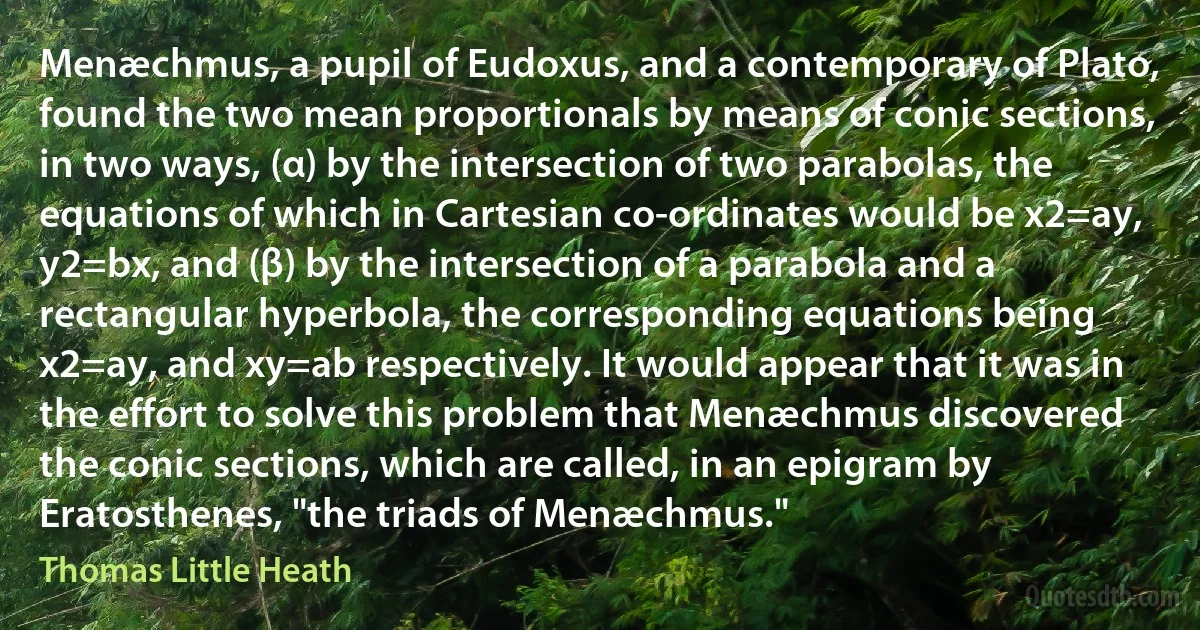
Menæchmus, a pupil of Eudoxus, and a contemporary of Plato, found the two mean proportionals by means of conic sections, in two ways, (α) by the intersection of two parabolas, the equations of which in Cartesian co-ordinates would be x2=ay, y2=bx, and (β) by the intersection of a parabola and a rectangular hyperbola, the corresponding equations being x2=ay, and xy=ab respectively. It would appear that it was in the effort to solve this problem that Menæchmus discovered the conic sections, which are called, in an epigram by Eratosthenes, "the triads of Menæchmus."
Thomas Little HeathRelated topics
appear cartesian conic contemporary effort epigram found intersection mean parabola problem pupil means waysRelated quotes
Today there really aren't that many Fundamentalists left; I don't know if you know that or not, but they are such a minority; there aren't that many Fundamentalists left in America. ... Now the word "fundamentalist" actually comes from a document in the 1920s called the Five Fundamentals of the Faith. And it is a very legalistic, narrow view of Christianity, and when I say there are very few fundamentalists, I mean in the sense that they are all actually called fundamentalist churches, and those would be quite small. There are no large ones.

Rick Warren
The first objection to Darwinism is that it is only a guess and was never anything more. It is called a "hypothesis,” but the word "hypothesis,” though euphonioous, dignified and high-sounding, is merely a scientific synonym for the old-fashioned word "guess.” If Darwin had advanced his views as a guess they would not have survived for a year, but they have floated for half a century, buoyed up by the inflated word "hypothesis.” When it is understood that "hypothesis” means "guess,” people will inspect it more carefully before accepting it.

William Jennings Bryan
Mathematicians may flatter themselves that they possess new ideas which mere human language is as yet unable to express. Let them make the effort to express these ideas in appropriate words without the aid of symbols, and if they succeed they will not only lay us laymen under a lasting obligation, but, we venture to say, they will find themselves very much enlightened during the process, and will even be doubtful whether the ideas as expressed in symbols had ever quite found their way out of the equations into their minds.

James Clerk Maxwell
George Orwell once wrote: "And it's not a matter of whether the war is not real or if it is. Victory is not possible. The war is not meant to be won, it is meant to be continuous. Hierarchical society is only possible on the basis of poverty and ignorance. This new version is the past and no different past can ever have existed. In principle the war effort is always planned to keep society on the brink of starvation. The war is waged by the ruling group against its own subjects and its object is not the victory over either Eurasia or East Asia but to keep the very structure of society intact."

Michael Moore
[T]he mass-man sees in the State an anonymous power, and feeling himself, like it, anonymous, he believes that the State is something of his own. Suppose that in the public life of a country some difficulty, conflict, or problem presents itself, the mass-man will tend to demand that the State intervene immediately and undertake a solution directly with its immense and unassailable resources. This is the gravest danger that to-day threatens civilisation: State intervention; the absorption of all spontaneous social effort by the State.

José Ortega y Gasset
